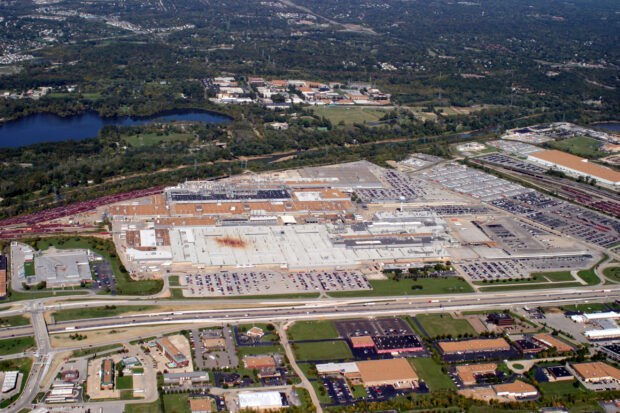HOME | ABOUT US | MEDIA KIT | CONTACT US | INQUIRE
HOME | ABOUT US | MEDIA KIT | CONTACT US | INQUIRE
Contrary to the politicians’ buzz, we do indeed make things in America. Exhibit A: Manufacturing in Missouri. But a lot more is going on here, too.

PUBLISHED AUGUST 2025
Is Missouri a manufacturing powerhouse? Let the numbers answer the question. In 2024, Missouri’s real GDP reached $356.7 billion, and manufacturing kicked in $50 billion of that. The sector employs 287,000 people—nearly one in eight private-sector jobs statewide.
That employment army churns out fighter jets, trucks, chemicals, packaged foods and much more. In fact, at 12 percent of state GDP, manufacturing is a more significant piece of the economic pie here than it is in Texas or Pennsylvania (11 percent), or California (10 percent).
But that pillar alone is not holding up the Show-Me State’s economy. The Professional and Business Services industry, in fact, was even larger, contributing $52.1 billion to state GDP last year. Not too far behind were Real Estate, Rentals and Leasing ($44.1 billion) and Health Care/Social Services ($33.9 billion).
Services, in general, account for a substantial portion of Missouri’s job market, representing roughly three-quarters of all jobs.
Broad-based growth has positioned Missouri among the nation’s most diversified economies, with only three states ranking higher last year, according to state officials. Such resilience has paid off during economic downturns: Federal Reserve research shows Missouri weathers national recessions better than most, entering downturns later and recovering faster.
Pillars of Missouri’s Economy
Advanced Manufacturing. Beyond Boeing’s St. Louis production of F/A-18 Super Hornets and F-15EX jets, Missouri hosts major auto plants for Ford and GM, which have invested billions in the state. Food processing, chemicals, and electrical equipment further solidify its industrial base. Missouri’s central location, robust transportation network, and skilled workforce contribute to its appeal for advanced manufacturing businesses like those and other global brands such as Emerson and Honeywell.
Biosciences. St. Louis and Kansas City anchor a thriving life-sciences sector, but Missouri’s crown jewel is its segment of the 250-mile Animal Health Corridor that runs from Columbia to Manhattan, Kan., in the west. That region alone is home to operations of firms generating 60 percent of global animal-health revenues. St. Louis and Kansas City have planted their flags in life-sciences niches to build their local ecosystems—the former, with entities like the Danford Plant Science Center, and the latter with the Stowers Institute for Medical Research, both highly regarded in the bioscience space.
Financial & Professional Services. The superlative “unique” is often overused, but Missouri indeed is unique as a center of finance; it’s the only U.S. state that is home to two Federal Reserve System district banks (St. Louis and Kansas City). Rapid growth at a pair of Missouri’s bigger banks, UMB and Commerce, has propelled them from regional players into powerhouses operating across multiple states. The state’s AAA credit ratings in the public realm and cost-competitive professional firms in the private sector help make it a magnet for financial services.
Health Care & IT. Though its role in the Kansas City market isn’t quite what it once was before it became what is now Oracle Cerner, the company remains a health-care IT giant and major employer in the Kansas City region. In St. Louis, major health systems like BJC Health and Ascension serve millions across the Midwest. The sector’s growth reflects broader trends in tech-driven care.
Military & Defense. With the Army’s base at Fort Leonard Wood, and the Air Force set up at Whiteman Air Force Base (home to B-2 Stealth bombers that wiped out Iran’s nuclear-bomb-making capacity this summer), and multiple defense contractors, Missouri plays an outsized role in national security, as well.
Transportation & Logistics. This part of the country has been a transportation hub since the first steel track was laid for railroads in the 1800s, but continuous expansion of the physical infrastructure (highways and airports as well as Class I rail lines) has combined with seismic shifts in consumer buying patterns to elevate Missouri’s role in distribution and warehousing. The Kansas City region, as one example, is now home to six Amazon warehouse facilities, and the company has shot up the charts of the region’s biggest employers.
Kansas City and St. Louis are emerging as powerful distribution rivals to Chicago and Dallas, fueled by industrial-space demand and the merger that produced Canadian Pacific Kansas City. The state’s extensive highways, waterways, and rail terminals cement its status as a national logistics hub.
The Bottom Line
Missouri’s economic mix—spanning defense, finance, biosciences, and logistics—offers a blueprint for resilience. As supply chains shift and industries evolve, the Show-Me State’s diversified foundation may prove its greatest advantage.
An abundance of thriving business sectors, according to the state’s Department of Economic Development, has thrust Missouri into the upper echelon of U.S. states in terms of diversification—only three other states had more diverse economies last year.